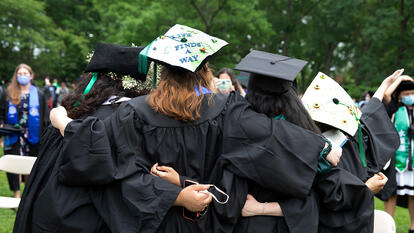Wellesley Kicks Off National Poetry Month with Poetry on the T, Community Events

April 1 marks the launch of Wellesley’s community celebration of poetry in recognition of National Poetry Month, starting with Poetry on the T, a new collaboration with Mass Poetry. In one car on each of the four MBTA subway lines (red, orange, blue, and green), riders will find poems by members of the Wellesley community displayed in what is usually an advertising space. Twenty-nine Wellesley students, faculty, staff, and alumnae submitted poems to the project.
“Poetry has great power to bring people together,” said Wellesley President Paula A. Johnson. “Never has the world more needed its healing, connective force—so beautifully displayed in the work of our community members. We are pleased to help advance the role of poetry in our culture and to join forces with Mass Poetry to share its magic with everyone.”
Mass Poetry, which brings poetry to readers of all ages and seeks to transform lives through inspiring verse, started Poetry on the T in 2014 “to enliven the commutes of millions of MBTA riders in Greater Boston,” said Daniel Johnson, executive director. Of this latest iteration with Wellesley, Johnson said, “It’s truly an amazing body of work—from students to faculty and from police dispatchers to digital content directors—it shows that the Wellesley College community lives and breathes poetry.”
On April 23, Mass Poetry is bringing another of its innovative programs, Student Day of Poetry, to Wellesley. At the event, local middle and high school students will read, write, and perform poetry through workshops led by Wellesley students and faculty. “We’re excited to expand our reach to students and schools we haven’t worked with before,” said Sara Siegel, program director for Mass Poetry. “We hope to continue these partnerships to keep bringing poetry to these students in the coming years.”
Lulu Al-Saud ’21 and Sara Lucas ’22, poetry co-editors for the Wellesley Review, are student co-organizers of National Poetry Month at Wellesley. “At such an academically driven school as Wellesley, it can be easy at times to fall prey to the idea of ‘stress culture,’ and it becomes difficult for students to step outside of their own thoughts, take a deep breath, and maintain perspective on what is most important,” said Lucas. “When we take time to pause and write, we give ourselves a chance to process all that happens in our daily lives: our emotions, our experiences, our identities.”
The poetry celebration on campus includes a series of events open to both the Wellesley community and the public:
- April 2: Climbing PoeTree, the spoken-word duo of award-winning hip-hop activists Alixa Garcia and Naima Penniman, will perform.
- April 18: Poet Sumita Chakraborty ’08 will read from her work.
- April 25: Poets Natalie Scenters-Zapico and Phillip B. Williams will give a joint poetry reading.
Capping off the month will be a day-long community celebration of poetry on April 26 that co-organizers Dan Chiasson, Lorraine C. Wang Professor of English, and Suzanne Langridge, director of the Paulson Ecology of Place Initiative, designed to inspire and delight the Wellesley community as they move through the landscape. Activities will include a morning walk around Lake Waban—with poetry stops along the way—led by the Botanistas; “pop-up” poetry readings across campus; an open house at the Book Arts Lab in Clapp Library, where visitors can letterpress a poem; outdoor multimedia art installations by the Dynamic Interface Design class, and more. The day concludes with a performance by Wellesley Out Loud, Wellesley’s internationally ranked slam poetry team. All are welcome to drop in to any of the events.
“So many poets have thought about poetry as a form of attention to the natural world,” said Chiasson, who is the poetry critic for the New Yorker. “The Paulson Initiative inspired us to think about putting poetry into Wellesley’s magnificent landscape at one of most beautiful times of the year. I hope members of the Wellesley community will stop, even for a moment or two, and hear what Seamus Heaney calls ‘the music of what happens.’”



